Rare and Unusual Trees to Make Your Landscape One of a Kind
by Elizabeth Cornell Fake, Fairfax Master Gardener
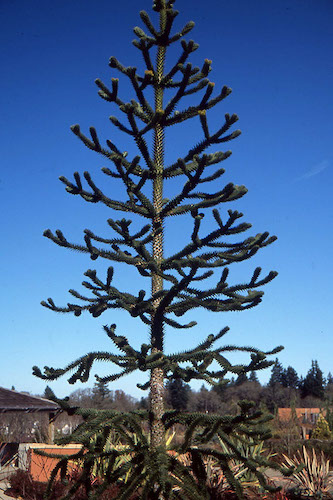
Monkey puzzle tree
One of the delights of a visit to a historic estate, of which we have many in Virginia, is the opportunity to see some rare and unusual trees. Many of our founding fathers were avid collectors and their interest in these species continues to delight visitors today. What most people do not realize is that it is far more feasible than in the 18th century to add some interesting varieties to a landscape today, and it does not require acres of land or a conservatory to do it. This article will explore the difference between rare and unusual trees, the advantages of adding unusual specimens to your landscape, some guidelines on selection and planting and end with a list of unusual deciduous, evergreen and deciduous conifer trees that are viable in our local Northern Virginia climate.
Rare trees are seldom seen in everyday landscapes and are often objects of curiosity in private gardens or exhibitions. Many of them are native to exotic locations or jungles, are hard to obtain, can be extremely expensive and require special accommodations to withstand winter. When visiting an arboretum, be on the lookout for some interesting, rare trees including: the Baobab Tree, the Dragon Blood Tree, the Cannonball Tree, Rainbow Eucalyptus, the Jabuticaba Tree, the Welwitschia Tree, and the Boojum Tree.
Unusual trees are less popular than traditional favorites such as oaks, maples and pines, are often non-natives, but can be found in our local gardens and landscapes. They are unusual because they stand out with their unique appearance, interesting growth patterns, bark, fruits or flowers and foliage. For the most part they are obtainable but are often expensive and require special care until they are established.
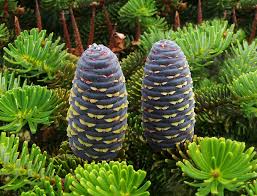
Korean Fir
Unusual trees attract attention in a landscape. As many of them have four season interest, they also create interesting focal points in a garden and will make your property stand out. From an ecological perspective, they provide habitat and food for wildlife while contributing to the biodiversity of a locale. Often planting unusual trees aids conservation of these species as some of them are now endangered. In cities where tree cover helps lower street temperatures during the summer, reduce the danger of flooding during storms, and increases fresh air circulation, unusual trees can add interest, beauty and can be a source of local pride in urban areas.
Selection and Planting Guidelines
- The most important consideration before adding an unusual tree to a landscape is to make sure there are no local regulations prohibiting the trees. Some are invasive or carry disease. Check with your local authorities or an extension service to find out ahead of time if your selection is a viable choice.
- Determine the mature size to see if you have adequate space to house a fully grown tree.
- Double check environmental conditions to make sure there will be proper sun exposure, soil composition and drainage.
- Unusual trees can be hard to find and are expensive. If possible, see the tree before purchase and be wary of end of season sales. If using an online source, check out the reputation of the company and read the reviews of past service.
- In the same way you would prepare to plant any tree, do a soil test to determine the site’s pH and nutrient levels. Unusual trees often have unique growing requirements.
- Given the expense involved, consider having a professional plant the tree for you.
- Understand that unusual trees follow different growth patterns than common varieties and may lag on the growth scale for three to four seasons. Be patient and resist the temptation to start over with a new sapling.
- Be prepared to smile frequently, accept compliments, educate interested parties, and answer endless questions about your latest acquisition.
Suggested Varieties
Unusual Deciduous Trees
Silver Birch (Betula pendula) is known for its silver white bark and stately columnar form and fares well in a Zone 7 climate. It does well in cold winters but needs at least six hours of sunlight and well-drained soil.
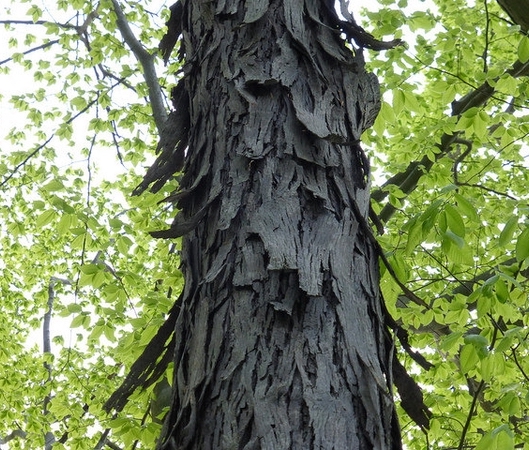
Shagbark hickory
Chinese Lacebark Elm (Ulmus parvifolia) catches attention from the way the bark exfoliates in small patches that turn green, gray, orange and brown giving a striking mosaic appearance. It is primarily ornamental, but a good habitat for wildlife.
Shagbark Hickory (Carya ovata) is visually captivating in the winter because of the long strips of bark that fall away making the tree look shaggy. It produces edible nuts enjoyed by humans and food for small game, birds and deer.
Persian Ironwood (Parrotia persica) features a smooth gray bark that peels away in fall to show varying shades of green, gray, white and tan underneath. This tree is notable for its flamboyant orange and red fall foliage.
Japanese Stewartia (Stewartia pseudocamellia) is a small to medium sized tree that blends well under the canopy. It is s four-season wonder with small white flowers in summer, vibrant orange and red foliage in fall and exfoliating bark leaving patches of gray, orange and reddish-brown tree bark in winter.
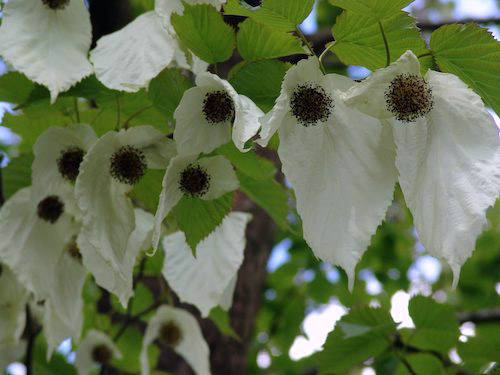
Dove Tree Blossoms
Katsura Tree (Cercidiphyllum japonicum) is a favorite among unusual trees that boasts heart shaped leaves with a sweet scent and yellow to orange foliage in fall. This tree is drought sensitive and requires full sunlight.
Dove Tree (Davidia involucrate) is a highly unusual tree (also known as the Handkerchief Tree) that draws attention with white bracts that look like hanging handkerchiefs or doves in spring. Slow to maturity, it takes several growing seasons to flower, but owners are rewarded with a truly remarkable sight.
Unusual Evergreen Trees
Eastern Red Cedar (Juniperus virginiana) is identified by its traditional cedar form and by the contrast between the lush emerald foliage and dark red tree bark. It produces small blue cones known as juniper berries which provide food for birds (cedar waxwings). Eastern red cedar requires ample space as it can grow to be very tall and large over time.
Korean Fir (Abies koreana) has distinctive fir with dark green needles and purple cones that stand upright even at a young age. It grows 15 to 30 feet tall and is prized for its ornamental value and ease of care. It also requires full sun and well-drained soil.
Golden Hinoki Cypress (Chamaecyparis obutsa ‘Crippsii’) is known for gold foliage that remains colorful throughout the year, even in winter. Its unique gold color makes it unusual among evergreens and is valued for its addition to the winter landscape. It needs bright sun to maintain color.
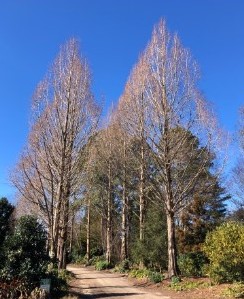
Dawn Redwood
Cryptomeria (Cryptomeria japonica ‘Elegans’) is also known as Japanese Cedar with foliage that turns from green to bronze/purple in winter. Seasonal color change makes it unique among evergreens, making it a standout addition to the garden.
Monkey Puzzle Tree (Araucaria araucana) is an exotic spiral tree with stiff leaf spikes that circle the branches creating a tree that stands out and is highly unusual. It is said that a monkey cannot climb this tree. This tree is valued for its unique appearance and capability to survive cool winter temperatures.
Unusual Deciduous Conifers
Dawn Redwood (Metasequoia glyptostroboides) is unique in that it was an ancient tree once thought extinct but rediscovered fifty years ago. It is characterized by a pyramidal shape and fine needles that turn gold before falling off in autumn, leaving a bare tree that adds elegance to the landscape in winter.
Bald Cypress (Taxodium distichum) is adapted to wetlands and can tolerate flooding but also thrives in drier climates. Its needles turn a deep rust color before shedding adding unique color and texture to the landscape in fall.
Golden Larch (Pseudolarix amabilis) is a pyramidal shaped ornamental tree requiring space to grow both horizontally (20 to 40 ft) and vertically (40 to 60 ft). Horizontal branching is unique and revealed when tufted gold needles shed in the fall. It produces flower-like cones in the summer.
-
References
- Selecting Landscape Plants: Rare and Unusual Trees, Diane Relf and Bonnie Appleton, Virginia Cooperative Extension, 426-604
- Resources for Trees, Shrubs and Groundcovers, Virginia Cooperative Extension